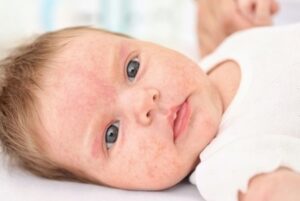 Do you have an infant whose skin is sensitive and prone to flare-ups? Are you wondering if the rash is caused by the heat or something else?
Do you have an infant whose skin is sensitive and prone to flare-ups? Are you wondering if the rash is caused by the heat or something else?
Many babies are born with sensitive skin, so your child could develop a blemish at some point. Breakouts are typically harmless, but they might indicate the presence of a potentially hazardous underlying condition.
It’s critical to understand what type of breakout your infant has so you can figure out the best treatment approach. We’ll help you do this by explaining why and the appearance of a baby heat rash. We’ll provide you with a strategy for preventing and treating baby heat rash and indicate when you should see a doctor.
Table of Contents
What is Child Heat Rash?
Heat rash, also known as irritable heat or miliaria, isn’t an infection. “heat breakout” refers to a skin condition that develops when your baby’s skin becomes too hot. Heat breakout happens when sweat gets trapped in your baby’s pores.
When your child’s body heat rises, their skin begins to sweat (which is a thermal buffer for the body). Sweating generally just flows out through pores when it decreases. On the other hand, children have tiny pore openings that may easily get blocked.
The summer season is one of the most common times for a heat rash breakout t since we all sweat more while it’s hot outside. Humid climates can also cause rashes. However, this skin condition does not just occur when the temperature rises!
It may also occur when it’s chilly, especially if your child wears a lot of clothing. When you go inside, remember to remove any layers.
Fortunately, heat rash isn’t as bad as it sounds. Babies are prone to heat rash, which usually goes away in a few days with prompt treatment.
Causes for Baby Heat Rash
Here are some of the causes of heat rash:
- Premature sweat ducts. Because a newborn’s sweat ducts are still developing, they risk getting heat rash. Heat rash is more likely to develop if your baby is in a NICU incubator with a high temperature or is overdressed.
- Heat. The most typical cause of heat rash is exposure to warm, damp climates.
- Workout. Exercises that cause sweating can also make heat rash more probable.
- Overdressing. Overheating due to putting on too many layers or lying beneath numerous coverings can result in a heated rash.
Types of Heat Rash
 Miliaria occurs when the skin traps perspiration, and the sweat irritates the outer layer of the the skin, causing a rash.
Miliaria occurs when the skin traps perspiration, and the sweat irritates the outer layer of the the skin, causing a rash.
Dermatologists divide heat rash into three categories based on its intensity:
- Miliaria crystalline: The least severe form of heat rash. This occurs when there is a blockage in the sweat glands in the skin. Small clear or white ulcers may develop due to heat eruption.
- Miliaria Rubra: It’s one of the most typical forms of heat rash. This outbreak happens when a blockage develops in the gland near the skin’s surface or dermis, causing inflammation, itching, and bumps.
- Miliaria Profunda: Extremely rare, but it is the most severe form of a breakout. Sweat that leaks into the dermis can cause severe flushing and burning. Infants with miliaria profunda may develop heat exhaustion symptoms. The infection may become inflamed to a point where it becomes dangerous.
The inflammation in heat rashes may be more visible on light skin and more challenging to detect on dark skin, but the underlying process that creates discomfort is the same. VESICLES are the small bumps seen in heat rashes, and these bumps, especially inflamed ones, frequently lead to miliaria pustulosa. Inflammation and inflammation are more typical in infants.
Miliaria pustulosa can decrease infants’ sweating, raising their risk of heat-related illness.
Signs and Symptoms of Heat Rash
The only sign of heat rash in most infants is a breakout on areas of the body that have previously been exposed to heat.
There are numerous reasons why swaddling might be detrimental to your baby’s development. Swaddling, nice clothes, poor airflow, and close to heat sources such as space heaters all contribute to the risk. A caregiver could observe a rash on the part of the body that was especially hot.
Rashes of all kinds are more likely to occur on areas of the body with folds, such as the neck or scrotum.
The following are some of the common signs of heat rash:
- If you notice a red rash,
- sores on a large region of the skin with tiny pin-sized ulcers
- hot skin
Heat rash generally goes away rapidly and does not cause excessive suffering, so it may not be necessary to visit a doctor.
Heat rashes are easy to identify, especially in the summer. If a caretaker is unsure whether or not a breakout has occurred, a doctor can typically determine it based on its appearance.
Treatments for Baby Heat Rash
When you detect that your child has a heat rash, it’s time to act. Do the following to treat baby heat rash:
- Get rid of Clothing: Take off your infant’s clothing since it most likely restricts the skin and aggravates the condition.
- Begin the Cool Down: Take your infant to a cooler place, such as an air-conditioned area or a tree’s shade. A clean, cool towel is a fantastic method to get the body temperature back to normal.
- Keep the skin dry: When you’ve entirely cooled down your infant, it’s vital to check the skin is dry. Allow your kid to air dry. Don’t use a towel since it may irritate the rash even more.
- Loosened Clothes: When it’s time to re-dress your infant, and they’re cold, choose loose-fitting clothing. Tight clothing will scratch the pimple and cause further discomfort.
- No Scratching: It’s hard to stop a baby from scratching, but you must try your best to limit your baby’s options. A sore might become infected if it develops. To reduce the likelihood of blisters forming, you should trim your child’s fingernails.
- No ointments: Lotions or ointments should not be used on heat rash breakout unless a doctor advises. Lotions and creams can make heat rashes worse.
How to Prevent Baby Heat Rash
 Follow these tips to avoid baby heat rash and, ultimately, a fussy baby:
Follow these tips to avoid baby heat rash and, ultimately, a fussy baby:
- Frequently check in: Check your baby’s skin every now and again to be sure it isn’t moist, excessively hot to the touch, or turning pink. If you think your baby is becoming too hot, a fantastic washcloth might be used to assist cool their body temperature down. Pay particular attention to the neck, armpits, and lower legs.
- Dress for convenience: If you’re finding it difficult to get your baby ready, remember that they may be uncomfortable. If you’re getting heated, so is your baby. Weather-appropriate and free-flowing clothing can help prevent heat rashes by keeping your child cool.
- Hydration: If your baby’s skin isn’t adequately moistened, it can overheat much more rapidly. Ensure your kid gets enough milk; if they’re old enough, offer them water.
- Limiting car rides in warm temperatures: A car seat has no ventilation, and your rear-facing infant isn’t receiving enough of the cooling you’re providing from the front of the car. There’s a high chance that the sun is beating down on your infant. You may purchase an automobile shade deflector to make the trip cooler. If you must be in the automobile for an extended period, plan your journey for the early morning.
- Preventing nighttime heat: Short-sleeved pajamas are an option if your kid gets too warm at night. Consider using a fan in your baby’s room at night. You should not point it directly at your infant but rather in the direction of the air circulation.
- Stay out of the sun: If you know it will be a very hot day, you should probably look for something to do indoors. If you have to go outside, seek a shady location or cover your infant’s head with a sun hat to keep them cool.
When to See a Doctor for Baby Heat Rash
In most situations, heat rash is a minor problem. Typically, it self-resolves when treated appropriately, as long as you follow the advice for dealing with and avoiding heat rash presented in this article. However, be on the lookout for the following:
- Increased discomfort
- Breakout lasting longer than three or four days
- Chills
- Pus draining pipes from the bumps
- Hunger loss
- Fever
Talk to your baby’s doctor for more assistance if you’re experiencing any of these symptoms with a basic breakout problem.
Final thought Baby Heat Rash
Heat rash isn’t always severe. Nevertheless, it might indicate that the kid is on the verge of overheating. Overheating can lead to a slew of significant health concerns. Therefore it’s critical to pay attention to the warning and move the baby to a cooler location. The rash will go away more quickly if the infant’s temperature is kept cool and comfortable.
If the breakout does not go away on its own after a few days, if the baby appears stiff or if the rash grows outward, seek medical help.

